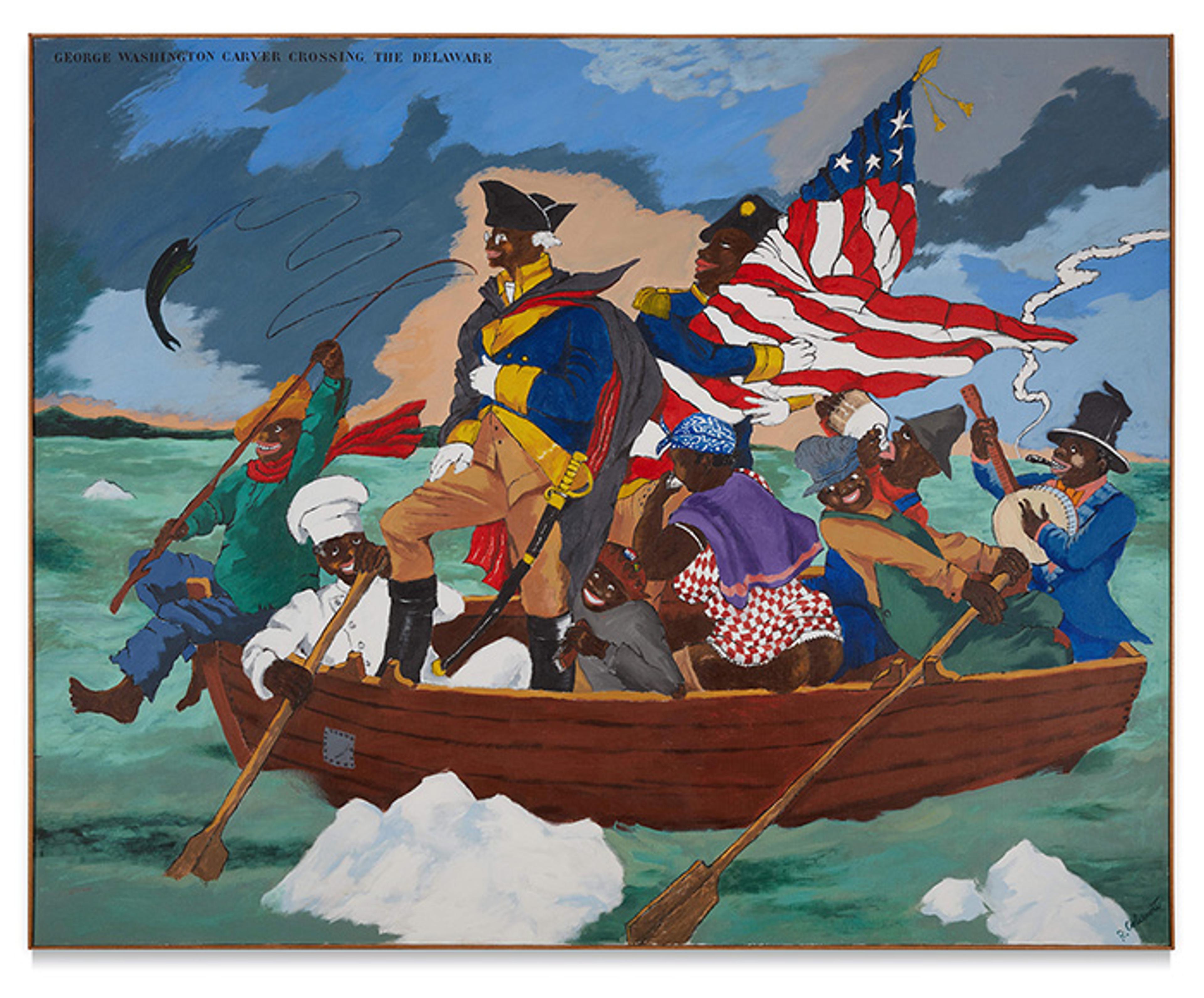
Emanuel Leutze (American, Schwäbisch Gmünd 1816–1868 Washington, D.C.). Washington Crossing the Delaware, 1851. Oil on canvas. Gift of John Stewart Kennedy, 1897. The Metropolitan Museum of Art, New York, 97.34
On view in the American Wing Gallery 767 through February 28th is a special display, Crossings, that explores ongoing resonances between past and present artistic expressions—specifically, modern and contemporary responses to Emanuel Leutze’s epic Washington Crossing the Delaware (1851). Evoking patriotic feelings in some viewers, conflict and struggle in others, this commanding icon—an unavoidable highlight of The Met’s American Wing—continues to spark debates about political ideas.
In the more than century and a half since Leutze painted the canvas, several artists—especially those of color—have responded to the contrived subject, from Black Americans Jacob Lawrence, Robert Colescott, and Kara Walker to Indigenous (Cree) Kent Monkman. Each of their works confronts the biases of American history and mythmaking, while revealing the critical role art plays in shaping popular narratives.
Colescott’s subversive take, painted in anticipation of the nation’s bicentennial, places the trailblazing scientist, inventor, and African American hero George Washington Carver at the helm of a boatload of Black stereotypes. The satire challenges viewers to accept the insidiousness of racism in popular culture as well as the urgency of truthful histories. Indebted to Colescott’s example, Walker’s The Crossing (2017) interrogates U.S. power and patriotism in ways ever more relevant since the violent attack on the Capitol on January 6, 2021. The diptych responds to two paintings at The Met that address the realities of a precarious ship of state, the Leutze and Winslow Homer’s The Gulf Stream (1899, reworked by 1906).
This intervention is the second part of a contemporary coda to The Met’s recent exhibition Winslow Homer: Crosscurrents, now on view in reduced form at London’s National Gallery. While many of our Homers are on loan, others may be found in American Wing galleries 762 and 769.

Robert Colescott (American, 1925–2009). George Washington Carver Crossing the Delaware: Page from an American History Textbook, 1975. Acrylic on canvas. Lucas Museum of Narrative Art, Los Angeles, 2021.45.1
“If George Washington crossing the Delaware is Carver, should I cry for the solitary hero and history because it allowed only one or maybe two heroes, but a multitude of buffoons (me included)? Or, on the other hand, how about all the hat changing, tap dancing, no-boat-rocking soft-shoe, no-wave-making ball-jiggling routines everybody’s man’s man might be doing to be everybody’s man? Now, that’s entertainment.”—Robert Colescott, 1981
Colescott was among the first artists of color to directly take on Leutze’s icon, transforming what he termed a “quasi-religious image” into an audacious burlesque that spotlights another kind of history. By surrounding the African American hero Carver with arch, pre-Civil Rights era stereotypes, the artist confronts the token representation of Black pioneers in history textbooks shaped by the prevalence of racist ideology. The work has become Colescott’s most famous and misunderstood image, leading to his refusal to be characterized as someone who “paints art history in blackface.”

Kara Walker (American, born 1969). The Crossing, 2017. Watercolor, charcoal, graphite on paper. Collection of Neda Young.
Kara Walker (American, born 1969). The Crossing, 2017. Watercolor, charcoal, graphite on paper. Collection of Neda Young.
Kara Walker is famous for her powerful and often controversial artworks that challenge romanticized narratives of America’s past. On January 20, 2017, the day of the inauguration of Donald J. Trump as the 45th U.S. President, the artist began this monumental drawing. While referencing a number of iconic works, it alludes primarily to Leutze’s Washington Crossing the Delaware. Reflecting the political chaos of the election and its aftermath, Walker depicts the paper-cap-wearing captain of an immobilized ship of state leading the country into iceberg-strewn disaster, while diverse figures struggle and seek escape. This is the first public display of The Crossing, a reproduction of which initially appeared in the New Yorker.
